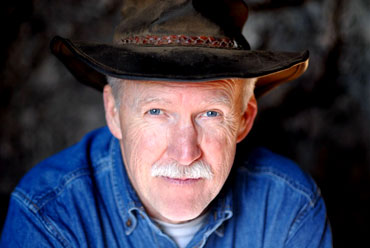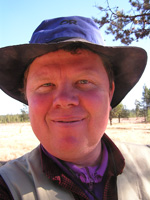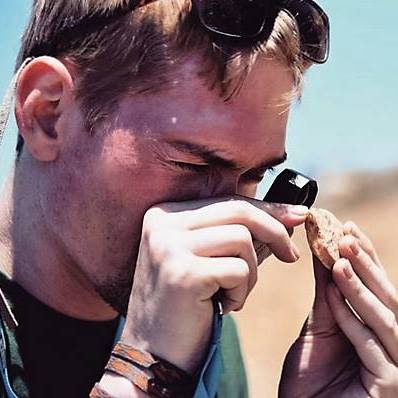Northern Great Basin Prehistory Project
Archaeological Field School
2018 Summer Session
Teaching Faculty and Staff
Dr. Dennis L. Jenkins

Photo by Andrew Curry
Jenkins is a Senior Staff Archaeologist for the Museum of Natural and Cultural History at the University of Oregon, Eugene. He received his B.A. (1977) and M.A. (1981) from the University of Nevada, Las Vegas where he worked with Claude N. Warren and Margaret M. Lyneis. His early research focused on the Virgin Branch of the Anasazi and Lake Mohave-Pinto sites in the Mojave Desert. He received his Ph.D. (1991) from the University of Oregon where C. Melvin Aikens served as his Committee Chair. He has worked for the Museum at the UO, where he serves as a research archaeologist assigned to Oregon Department of Transportation archaeological projects in the Northern Great Basin, Columbia Plateau, and Klamath Basin, since 1987. He has been teaching, supervising, and directing the Northern Great Basin archaeological field school since 1989. In that capacity he has overseen the education of more than 500 field school students in the methods and theory of archaeological field investigations.
His stint as a project field director at Fort Irwin, California provided him a unique set of interpersonal and interagency experiences that developed in him an exceptional ability to find common ground with diverse groups and individuals alike. This talent, based on honesty and proven trustworthiness, has served him well through nearly 30 years of program construction, personnel handling, and interagency consultations involving working closely and successfully in sensitive negotiations with Native American tribes in Oregon.
Jenkins’ primary research interests are the Paleoamerican colonization of the Americas, ancient human DNA, Great Basin hunting and gathering societies, obsidian sourcing and hydration analysis, and settlement-subsistence patterns in arid lands of the American West. He has conducted archaeological research at >100 sites in Nevada, California, Arizona, and Oregon. His research spans the late Pleistocene (12,400 radiocarbon years ago) through the entire Holocene period including excavations in a Chinese shanty town at Jackson, Oregon, mapping of the town site of Jefferson in Nevada, and excavation of a historic wickiup (ca. 1854) at Boulder Village in the Fort Rock Basin.
Jenkins has authored and co-authored 8 books, 44 chapters, journal articles, reviews, and published papers, 33 major professional reports, and given 62 professional papers and symposia at conferences. His doctoral thesis, Site Structure and Chronology of 37 Lake Mojave and Pinto Assemblages from Two Large Multicomponent Sites in the Central Mojave Desert, Southern California, was the culmination of four years of research focus on the late Pleistocene and early Holocene archaeology of the Mojave Desert as the Field Director of the Fort Irwin Archaeological Project near Barstow, California. Through the UO field school he has conducted new excavations at the famous Connley Caves and Paisley 5 Mile Point Caves sites, recovering the oldest directly dated human remains—12,400 RCYBP mitochondrial DNA in human coprolites—in the Americas from the Paisley Caves (Gilbert et al. 2008; Jenkins 2007; Jenkins et al. 2012, 2013).
Jenkins has filmed multiple short documentaries for public education. The first, Paisley Cave Dig, was an Oregon Field Guide segment produced for Oregon Public Broadcasting (OPB) of Portland, Oregon. This 10 minute program showed UO field school investigations at the Paisley Caves in the Summer Lake Basin of central Oregon, ending with a brief synopsis of preliminary findings as of the 2003 summer field session. Tracking Obsidian, filmed by OPB in 2004, was a segment explaining the search for the location of an as yet unlocated obsidian source near Silver Lake in the Fort Rock Basin just north of the Summer Lake Basin. The on-site interview, Finding Pre-Clovis Humans in the Oregon High Desert: An interview with Dennis Jenkins, is a 40 minute segment filmed at the Paisley Caves by The Archaeology Channel during the summer of 2007. It covers the topic of recovering human DNA from coprolites in the caves. It was released with the publication of an article in Science Magazine. Finally, Jenkins filmed the lead segment (about 7 minutes) for a two hour documentary entitled All About Dung produced by Icon Films (Bristol, United Kingdom) for the History Channel. This very entertaining investigation into the fascinating and funny topic of pooh was aired in June 2008. Finally, he filmed another 7 minute segment for "Ice Age Geology", shown on the History Channel in March, 2010. He currently has made appearances in a documentary by OPB about Luther S. Cressman and the in one about Eske Willerslev and the Paisley Caves made by Danish TV.
Dr. Patrick O'Grady

O'Grady is a third-degree Duck, having earned his B.S. (1996), M.S. (1999), and Ph.D. (2006) from the University of Oregon. He has served on eighteen University of Oregon field schools since 1994, first as a student, then as an assistant, supervisor, and instructor. His primary research interests include hunter- gatherer subsistence practices, late Pleistocene/early Holocene cultural trends in the Great Basin of western North America, zooarchaeology, patterns of mobility, and remote sensing applications in archaeological contexts.
His Master's research "Human Occupation Patterns in the Uplands: An Analysis of Sourced Obsidian Projectile Points from Playa Villages in the Fort Rock Uplands, Lake County, Oregon" was an exploration of highland village settlement and mobility patterns in the uplands between the Fort Rock and Summer Lake basins in south-central Oregon. His Ph.D. research "Before Winter Comes: Archaeological Investigations of Settlement and Subsistence in Harney Valley, Harney County, Oregon" is an examination of mid to late Holocene multi-elevation land use patterns encompassing wetland to upland settings within a large, well-watered valley in the Great Basin. Master's and doctoral researches were conducted under the direction of Dr. C. Melvin Aikens.
O'Grady is a staff archaeologist at the University of Oregon Museum of Natural and Cultural History. He was an archaeologist for the Oregon Department of Transportation from 2002-2005, and has also worked for the Burns District Bureau of Land Management, which was instrumental in funding his dissertation research during the 2000-2002 field seasons. Recent publications include "Zooarchaeological Analysis of Cultural Features from Four Early to Middle Holocene Sites in the Fort Rock Basin" in Early and Middle Holocene Archaeology in the Northern Great Basin, edited by Dennis L. Jenkins, Thomas J. Connolly, and C. Melvin Aikens (University of Oregon Anthropological Papers 62) and "Housepits in the Chewaucan Marsh: Investigations at the Gravelly Ford Bridge Site" by Brian L. O'Neill, Dennis L. Jenkins, Charles M. Hodges, Patrick O'Grady, and Thomas J. Connolly in Beads, Points, and Pit Houses: A Northern Great Basin Miscellany, edited by Brian L. O'Neill (University of Oregon Anthropological Papers 66). He taught the 2007 through 2015 field schools at the Sage Hen Gap, Sheep Mountain Clovis, and Rimrock Draw Rockshelter sites and looks forward to continuing challenges at Rimrock Draw Rockshelter in the future.
Justin Holcomb

Justin Holcomb is a PhD Candidate within Boston University's Department of Archaeology. He studied Anthropology and Geoarchaeology at Texas A&M University (BA) and Oregon State University (MA), respectively. His current research apples multi-scalar geoarchaeology to the study of global hominin dispersal, and he is involved in research spanning Greece (Mani Peninsula, Naxos, Crete), Iceland, and the Americas (Oregon, Texas).
He will be teaching a geoarchaeology field methods course concurrently at Connley Caves. The course requires enrollment separate from the archaeology field course.
Kayelyn McDonough